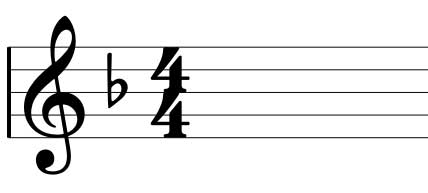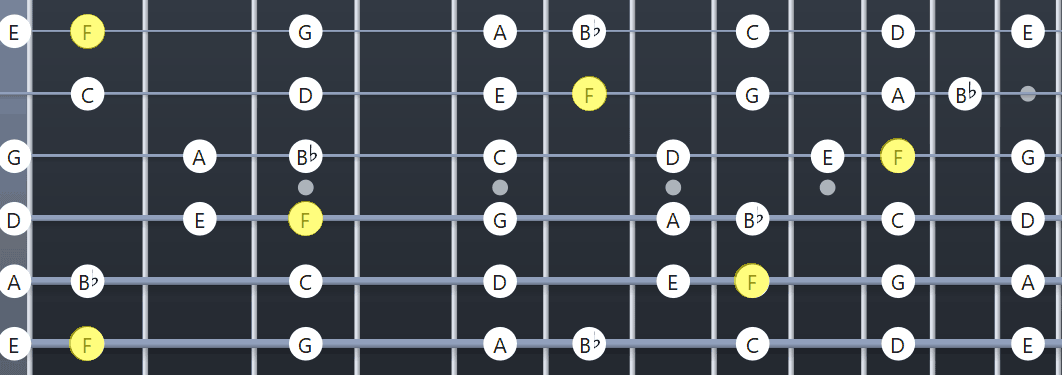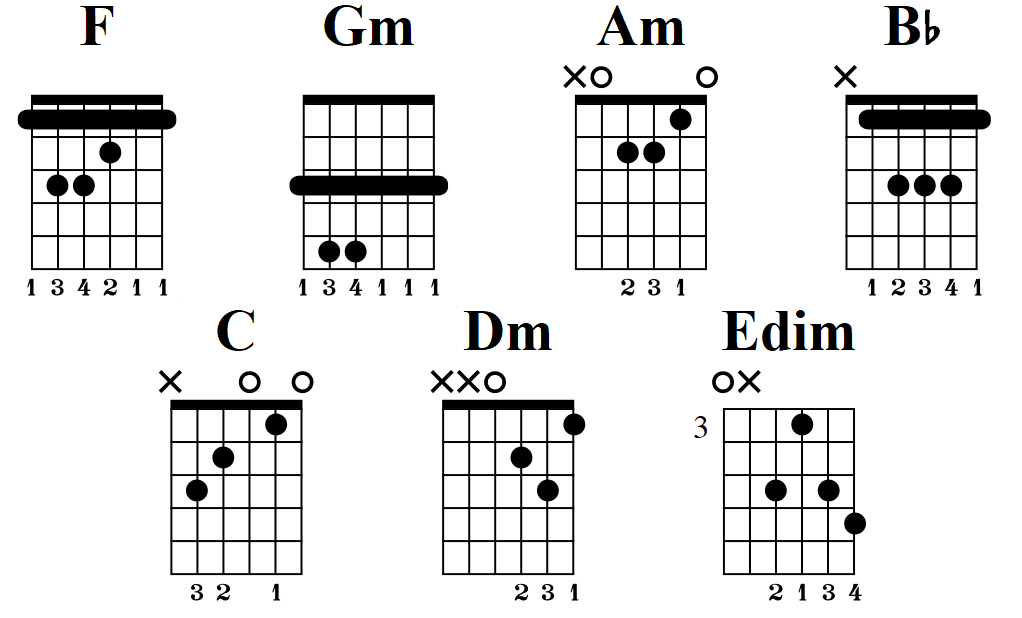The F Major Scale is an easy scale to learn on guitar. After you learn the C Major Scale, you can easily learn the F Major and G Major scales.
This guide covers everything you might want to know about the F Major scale including common open chords, note positions on a fretboard diagram, and more.
These resources are based on having your guitar in standard tuning. Read this guide on Alternate Guitar Tunings if you want to try something different.
Learn different guitar scales in these guides:
F Major Scale = D Minor Scale
For every Major scale in music, there is what we call a ‘relative’ minor. A ‘relative’ scale is one that uses the same notes but is used in different ways. This means for every Major scale, there is a minor scale using the same notes.
The F Major scale and the D minor scale both use the exact same notes. The main difference between the two (to keep things simple) is the root note of each scale. In the F Major scale, the root note is ‘F’. In the D minor scale, the root note is ‘D’.
Once you learn some basic music theory you will understand how two different scales can use the same notes, but for now, all you need to do is remember that both F Major and D minor scales use the same notes.
This means you can use all the diagrams, exercises and chords covered in this guide for both the F Major scale and the D minor scale.
The D minor scale is an incredibly popular scale for guitarists when tuned to Drop-D.
Drop-D combined with the D minor scale is the perfect combination for rock, metal, and similar styles.
Learn about Drop D Tuning in this guide.
The good news is that once you memorize the F Major (D minor) scale in standard tuning, it is easy to play it in Drop D tuning.
All you need to do is remember that the low E string is now a D string (same note positions as the fourth string) and everything else stays the same.
Notes in the F Major Scale
The F Major scale is easy to remember because it only contains one flat note. The notes in the F Major Scale are: F G A Bb C D E
Note: the little ‘b’ represents a flat symbol.
This is what the key signature for F Major looks like:

Even if you don’t know how to read music, if you see a key signature with only one flat symbol, it means the music is in F Major (or D minor).
The notes in the D minor scale are: F G A Bb C D E. As you can see, it’s the exact same notes as the F Major scale. The D minor scale starts on ‘D’ (called the root note) and the F Major scale starts on ‘F’, but both scales contain the same seven notes.
The key point to remember with the F Major scale is Bb (B flat). You only need to remember that the F Major scale uses B flat and all the other notes are natural (not sharp or flat).
This is why the F Major scale is so easy to learn after you learn the C Major scale. All you need to do to change from C Major to F Major is remember to lower the note B by one fret to get B flat.
F Major Scale Fretboard Diagram
Here are the notes of the F Major scale across the entire fretboard:

The main notes to focus on when you try to memorize this scale is F and Bb.
You want to pay extra attention to F because it’s the root note, so you want to be able to easily find those note positions while improvising or writing riffs.
You also want to pay attention to the Bb positions to help you switch into this scale from C Major.
Tip: you may notice that this scale doesn’t use the open B string. This is why the scale isn’t as popular as the C Major or G Major scales. If you accidentally play the open B string while in the key of F, you’ll notice that it sounds out of place.
Here is the F Major scale diagram up to the 12th fret with the root notes highlighted on each string:

Read my lesson on how to memorize the fretboard to get the most out of this diagram.
How to use the above fretboard diagram:
- Improvise over an F Major or D minor backing track by playing any of the above notes
- Learn to find chord shapes that fit with the highlighted notes
- Practice scale runs between any two points on the fretboard (don’t just stick to scale shapes you’ve already memorized)
- Memorize the notes on the fretboard one string at a time
If you’ve already spent time memorizing the C Major scale, it should only take a day or two of practice to fully memorize the F Major scale.
F Major Scale in Guitar TAB and Standard Notation
The below Guitar TAB and standard notation show four examples of the F Major scale starting on different root note positions:

If you don’t know how to read the above example, find out how to read Standard Notation in this guide and how to read Guitar TAB in this guide. Knowing at least one of these methods can significantly speed up your progress.
Try playing the four examples to get a feel for how F Major sounds and where the correct notes are on the fretboard.
Instead of merely running up and down scale shapes, I recommend learning to randomly walk around the fretboard by focusing on the note names.
This feels harder in the beginning, but once you learn how to do this with one or two scales, all of the other scales quickly fall into place.
Find out more on memorizing the fretboard in this guide.
F Major Scale Open Chords on Guitar
While some scales work really well with basic open chord shapes, scales like F Major don’t work as well.
To be able to fully harmonize the scale, you need to be able to play some basic barre chord shapes (or really awkward open chord shapes).
Here are the seven main chords in the F Major scale:

You probably already know how to play the chords Am, C, and Dm. All of the other chords apart from Edim (E diminished) are barre chords.
While the F Major scale is really easy to memorize, it may not be the best starting point for beginners if you want to write chord-based songs.
Once you learn how to play barre chords, the F Major scale becomes a lot more useful.
Don’t worry about memorizing Edim because you’re unlikely to use it.
Note: remember that the D minor scale uses the exact same notes as the F Major scale. This means the above chords also fit in the key of D minor.
As mentioned earlier, you shouldn’t rely on these resources. Learn how to memorize the notes on the fretboard. It might be easier to use a chart like the ones above to find your way across the fretboard, but you’ll become a far better guitarist if you properly memorize the fretboard notes.
Guitar Songs Using the F Major Scale
While the above chord shapes might make it look like F Major isn’t an easy scale to write songs with, there are plenty of well-known songs in the key of F Major or D minor.
Here are some popular guitar songs using the F Major scale:
- Come Together by The Beatles
- Still Got the Blues by Gary Moore
- Layla by Eric Clapton
- Another Brick in the Wall by Pink Floyd
- We Are the Champions by Queen
- Uprising by Muse
- Afterlife by Avenged Sevenfold
Songs in Drop D tend to work really well with the F Major scale. By focusing on the low open D string, the scale can be used to write songs in the key of D minor.
Check out Afterlife by Avenged Sevenfold or Everybody’s Fool by Evanescence for basic examples of songs in Drop D using the F Major scale.
Here are some other resources for guitar scales worth learning:
- C Major Scale – learn first
- G Major Scale – learn anytime after C Major
- D Major Scale – learn after G Major
- A Major Scale – learn after D Major
For more resources, check out these guides. You can get notifications on new resources, guides, lessons, and reviews by subscribing to email updates here.
